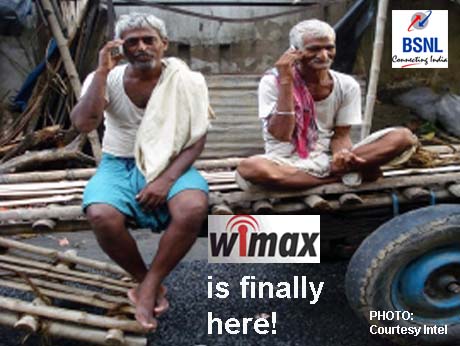
First rollout will be in rural reaches
BSNL, the government owned telecom provider, has chosen the borderline rural setting of Ajmer, Rajasthan to launch the country's first WiMAX-fuelled mobile broadband, promising minimum speeds of 1 MBPS and a peak 7 MBPS. The company had a headstart over all competition, since private players are still caught in a seemingly endless wait for the WiMAX and 3G spectrum auctions which in any case can’t happen in 2009.
In fact, it has taken BSNL almost a year to translate its WiMAX plans into reality – it first unveiled the technology a year ago at a telecom show in Delhi. BSNL’s rural offering is clearly, heavily subsidised -- at Rs 140 per month ( that is approximately $3) it is arguably the cheapest broadband service in the world -- and will be offered in 1000 ‘Block” headquarters ( groups of villages) across the country and this will in turn fuel some 11000 common service centres.
BSNL has partnered with Intel to source the embedded chip sets to fuel its WiMAX initiative.
The government’s release, Monday, speaks of igniting bank ATMS, tele medicine, rail reservations, utility payments, birth and death records… all worthy and archtype applications in a virgin communications scenario. But it remains to be seen whether push comes to shove when it comes to implementation.
However, BSNL seems to have done the sensible thing in going first for the rural market -- where even basic wireless internet may not be available… effectively helping this sector leapfrog over WiFi to the superior speeds and longer hops ( as much as 15 kms versus a few hundred metres of 802.11 WiFi).
When the private operators finally buy their spectrum, they will probably go for the high value urban customers to offset the stiff price they paid to set up their broadband infrastructure. In any case WiMAX may have to make its case against cellular 3G in that ‘maidan’ or field, when targeting the mass consumer, leaving WiMAX as a corporate/ enterprise option.
At a Delhi briefing, Intel maintained that WiMAX today (and WiMAX 2.0 : 802.16m tomorrow) was the best option, even when stacked up against cellular technologies like HSPA and LTE. R. Sivakumar, Managing Director, Sales and Marketing Group, Intel South Asia, lists the priorities he sees for India: a technology that can provide fixed, mobile and nomadic solutions to bridge the gap between rural and urban communities; enable rural health, education, commerce, & microfinance; leverage technology for safety programs, video surveillance; deliver eGovernance, making the government accessible to all through low cost devices and low cost services.
Once it was roti kapda aur makan ( food clothing and shelter). Today they offer a new mantra, Cellphone, Internet aur environment.
Tech note: Intel's WiMAX device initiatives have been enabled by the acquisition of crucial intellectual property in cutting edge WiMAX technology patents like MIMO ( Multiple In Multiple Out) at an early stage in the time line of the technology, from its India-born authors, Tom Kailath and A. Paulraj, both at Stanford University (US). Dr Paulraj, is now CTO of another key WiMAX chip player, Beceem Communications, whose development centres are at Santa Clara ( California) and Bangalore. Beceem created the industry's first single chip WiMAX solution which is today under the hood of many WiMAX-ready portable computers. So in a sense WiMAX coming to India is WiMAX coming home!
Anand Parthasarathy in Bangalore Dec 15 2009
( We have put a basic explanatory video about WiMAX in our home page Video slot -- courtesy Clearwater)